KHALID SHEIK MOHAMMED’s SCHEMES
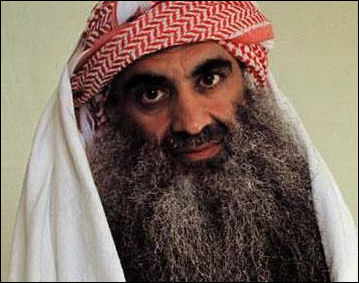
Khalid Sheik Mohammed in 2009 Khalid Sheik Mohammed, not Osama bin Laden, was the primary in figure in the plotting of the September 11, 2001 attack on the World Trade Center. . The attacks were his idea, carried out under his direct command. Mohammed has said that he refused to swear allegiance to bin Laden and Al Qaeda until after the attacks, so that he could pursue them if Al Qaeda lost its nerve. Khalid Sheik Mohammed reportedly was in contact with many Al-Qaida operatives. Those that knew him said he was often talking in one cell phone and sending a text message with another. Other arrested Al-Qaida operatives said he gave the the green light for the September 11th attack on September 10th. At the time of his arrest he was developing a scheme to crash hijacked fuel oil trucks into fuel pumps at filling stations while cables on suspension bridges were being severed with explosives.
Dina Temple-Raston wrote in the Washington Post: “He managed to turn himself into nothing less than the Kevin Bacon of terrorism. Nearly every major plot leveled against the United States from 1990 until years after the 2001 attacks had fewer than six degrees of separation from KSM. Either his family was involved, or his financing network coaxed something along, or he himself played a key role. His nephew Ramzi Yousef dreamed up the 1993 World Trade Center bombing. A KSM intimate partly financed the nightclub bombings in Bali, Indonesia. And the early reconnaissance for a 1995 plot to blow up a dozen American-flagged jetliners over the Pacific, according to McDermott and Meyer, was done by KSM himself. At various times during his captivity, KSM has confessed to a role in nearly three dozen plots. They ranged from aspirational — mulling the assassination of the pope and President Bill Clinton — to real horrors such as the murder of Wall Street Journal reporter Daniel Pearl.[Source: Dina Temple-Raston, Washington Post , June 8, 2012]
AP reported: “In his testimony to a military tribunal at Guantanamo Bay, released in redacted form by the Pentagon on Wednesday, Mohammed claimed involvement in 31 attacks and plots. Some are almost surely true. He was the mastermind of the 9/11 jetliner attacks and, in their wake, certified his bloodthirst by personally beheading Wall Street Journal reporter Daniel Pearl — bragging about it on the Internet then and in the testimony transcript..."I decapitated with my blessed right hand the head of the American Jew, Daniel Pearl, in the city of Karachi, Pakistan," he said. "For those who would like to confirm, there are pictures of me on the Internet holding his head?... His operations ranged from his admitted involvement in the 1993 attack on the World Trade Center, as well as a failed scheme known as Bojinka to bring down 12 Western airliners in Asia — claims that are well documented. Less certain is his claimed role in the October 2002 bombings that killed 202 people in Bali, Indonesia, and aborted plots to assassinate former U.S. presidents and Pope John Paul II. [Source: AP, March 16, 2007]
Character of Khalid Sheik Mohammed

Khalid Shaikh Mohammed after capture Peter Finn of Washington Post described KSM as “a man of no small ego” who craves attention. “A showman, he has reveled in a number of appearances at Guantanamo Bay, tossing self-aggrandizing broadsides from his perch at the front of a courtroom and then retreating into self-satisfied smiles...His vanity has also surfaced. He once complained that a courtroom sketch artist had drawn his nose too big. The rendering of the proboscis was adjusted. [Source: Peter Finn, Washington Post, November 14, 2009]
The 9/11 Commission Report, discussing Mohammed's terrorist ambitions, called him a "self-cast star." "I am the mastermind of 9/11, not Osama bin Laden," he said in one court hearing. "I know him well, and if he gets his way in federal court, it will be a circus," Charles D. "Cully" Stimson, who was deputy assistant secretary of defense for detainee affairs in the Bush administration, told the Washington Post. "The court will have to rein in his speechifying and keep the focus on his criminal behavior."
"He's a boastful character. I think after four years of silence, he'd probably like to be up there with the likes of bin Laden and Ayman al-Zawahri as a major figure and ideologue, and impress people with everything he's done," Ahmed Rashid, a Pakistan-based author on Islamic militancy, told AP. [Source: AP, March 16, 2007]
Dina Temple-Raston wrote in the Washington Post: “When the Red Cross visited him for the first time after his 2003 capture, KSM didn’t want to talk about waterboarding or the conditions of his confinement. Instead, his top priority was a photo shoot. He wanted the Red Cross to release a portrait of him with a proper long beard. Evidently, the picture released shortly after his capture (more about that later) — all threadbare T-shirt and wild hair — was driving him crazy.” [Source: Dina Temple-Raston, Washington Post , June 8, 2012]
Terry McDermott wrote in The New Yorker: “Insofar as we know Mohammed, we see him as a brilliant behind-the-scenes tactician and a resolute ideologue. As it turns out, he is earthy, slick in a way, but naïve, and seemingly motivated as much by pathology as by ideology. Fouda describes Mohammed’s Arabic as crude and colloquial and his knowledge of Islamic texts as almost nonexistent. A journalist who observed Mohammed’s appearance at one of the Guantánamo hearings likened his voluble performance to that of a Pakistani Jackie Mason. A college classmate said that he was an eager participant in impromptu skits and plays. A man who knew him from a mosque in Doha talked about his quick wit and chatty, glad-handing style. He was an operator. [Source: Terry McDermott, The New Yorker, September 13, 2010]
Ramzi Yousef
Ramzi Yousef, the mastermind of the 1993 attack on the World Trade Center, used Manila as a base for his plans and also worked out of Pakistan. He is the nephew of Khalid Shailkh Mohammed, an ethnic Pakistani born and raised in Kuwait and by some accounts was the number three man in Al-Qaida and the organizer of many of its activities before he was captured in Pakistan in March 2003.
Yousef had links with Al-Qaida but was regarded as a freelancer. Even so he is credited with making Al-Qaida a worldwide terrorist network. He hatched a plan to fly planes full of explosives in the CIA building and nuclear power plants. Some regard these as blueprints for the attack on the World Trade Center in New York on September 11, 2001. Many believe that if the CIA and the FBI took this plot more seriously September 11th could have been avoided.
Yousef was captured in Pakistan in February 1995 with a tip from an informer who was given a $2 million reward. A search a month earlier in a Philippines apartment, where Yousef stayed with his Filipina girlfriend, enabled police to discover his computer which contained files of some of his plots, as well as some bomb-making equipment. The search took place after one of Yousef’s cohorts, Abdul Hakim Murad, started a fire while mixing water with explosive chemicals in his sink. The computer files led to the arrest of 27 foreign terror suspects, including Adel Anonn, the owner of a Mindanao Meat Shop in Manila, and Yousef’s twin brother.
After Yousef was arrested in Pakistan he was quickly extradited to the United States. After he arrived in New York, FBI agents drove him by the World Trade Center and said, "See, it's still standing." He reportedly said, "If I had a little more money, it wouldn't be." Two Americans were killed soon after the extradition in what was believed to be a revenge killing. Yousef was tried and convicted in the United States and was sentenced to life in prison for masterminding the 1993 World Trade Center bombing. After the sentencing he said, "Yes, I am a terrorist and proud of it." He is now serving a life sentence at a prison in Colorado.
Ramzi Yousef Terrorist Plots and Attacks
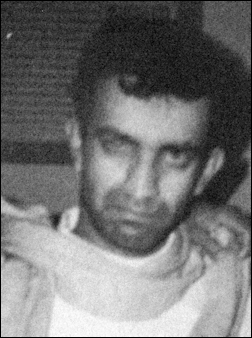
Ramzi Yousef after capture Yousef was involved in the bombing of a Philippines Airlines plane in 1994 that killed one Japanese and injured 10. In that attack Yousef planted the bomb himself under an economy class seat and got off the plane at a layover stop before the bomb exploded in the air. This attack was regarded as dress rehearsal for a plot to blow up12 United, American, Northwest, and Delta jumbo jets over the Pacific using the same technique and a new kind of explosive conjured by Yousef that was regarded undectable. The attackers planned to get on plane in Singapore, leave behind the explosives, get off in Hong King, while the flights continue on to Los Angeles, with the bombs set to go off while the planes were flying over the middle of the Pacific Ocean. The plan was never carried out. The plot was foiled in 1995 when Yousef’s computer was found out and
Twenty foreign Muslim extremist, including a Kuwati-Palestine "electronics expert," were accused of plotting to kill Pope John Paul II with a fragment bomb during a January, 1995 visit to the Philippines. Six days before the pope’s visit a tip off lead to the raid on a apartment that overlooked the pope’s motorcade route and was less than a mile from the residence where the Pope was going to stay. In the apartment police found at least four bombs with timing devises, several bibles, a priest's garb, maps of the pope’s route, and a large picture of the pope. The apartment was used by Ramziz Yousef. Before an open air mass given by the Pope, priests were frisked by security guards to make sure they weren't carrying any weapons. The government-supplied "Popemobile" used in the Philippines was a remodeled armored truck with four-inch-thick plates. The $200,000 vehicle was built to withstand machine-gun fire and grenade blasts. Yousef and Khalid also hatched a plan to assassinate Clinton. The 1995 plot to bomb 12 airliners and kill the pope involved Al-Qaida operatives such as Hambali.
Khalid Sheik Mohammed and Ramzi Yusef Hatch Early Terrorist Plans
His most constant companion appears to have been his nephew Abdul Basit Abdul Karim (later known as Ramzi Yousef). Terry McDermott wrote in The New Yorker: “Physically, the two were near-opposites. Basit was tall, lanky, usually clean-shaven, and rakish. Mohammed was more than half a foot shorter, stout, bearded, and bespectacled. What they shared was a rough charm that they used to persuade others to go along with what must often have seemed outlandish schemes. [Source: Terry McDermott, The New Yorker, September 13, 2010]
“They had spent time together in Peshawar, where Basit had visited in 1988, on a break from studying electrical engineering in Wales. He returned in 1991 and trained at Khalden Camp, in Afghanistan; he also taught courses in bomb-making, developing a reputation as a clever designer of explosive devices. The Arab mujahideen had argued about the future of their cause, debating whether it should be confined to Afghanistan until they prevailed there or broadened to confront corrupt Arab regimes elsewhere. Basit didn’t waste time on debates; he began making plans and proselytizing. One of his cousins later told investigators that during this period Basit inspired him to join the jihad beyond Afghanistan. Basit and Mohammed both frequently appealed to relatives for logistical support. Two of Basit’s cousins and at least two of his brothers have been accused of working with Mohammed.
“In 1991, Basit got in touch with Abdul Hakim Murad, a fellow-Baluchi and a boyhood friend from Kuwait, who was then in the U.S., training as a pilot. Basit told him that he wanted to attack Israel, but thought it too difficult. He would attack America instead. He asked Murad to suggest potential Jewish targets in the United States, and Murad agreed to think about it. After Murad finished his training and returned to the Gulf, in 1992, Basit got in touch again and asked if he had identified a target.
Attack on the World Trade Center in 1993
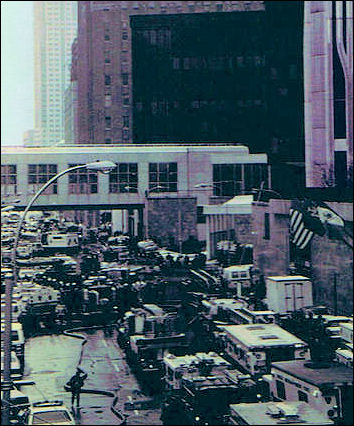
1993 World Trade Center Bombing On February 26, 1993, a 1,500-pound bomb planted in a van blew up in the underground garage of the World Trade Center in New York. Six people were killed and more than 1,000 were injured. The blast caused major damage to the building's foundations; some 55,000 people were working in the towers at the time. The terrorists had hoped to topple the skyscraper and release cyanide gas packed in a nearby truck. The cyanide was harmlessly burned up in the explosion.
Investigators determined that the cell built the bomb in New Jersey by consulting manuals brought from Pakistan. Some of the plotters acted foolishly. One of them went back to get his security deposit on the truck used in the bombing. Some of the plotters had links to Shiek Omar Abdel-Rahamn, the Blind Sheik who lashed out against Americans from his mosque in New Jersey.
On the background behind the 1993 World Trade Center attack, Terry McDermott wrote in The New Yorker: “In 1991, Basit got in touch with Abdul Hakim Murad, a fellow-Baluchi and a boyhood friend from Kuwait, who was then in the U.S., training as a pilot. Basit told him that he wanted to attack Israel, but thought it too difficult. He would attack America instead. He asked Murad to suggest potential Jewish targets in the United States, and Murad agreed to think about it. After Murad finished his training and returned to the Gulf, in 1992, Basit got in touch again and asked if he had identified a target. [Source: Terry McDermott, The New Yorker, September 13, 2010]
See Separate Article Attack on the World Trade Center in 1993 factsanddetails.com
Khalid Sheik Mohammed in the Philippines
After the attack on the World Trade Center in 1993 Khalid Sheik Mohammed his nephew Abdul Basit Abdul Karim (Ramzi Yousef) moved to Manila. Mohammed lived it up like a playboy while he lived in the Philippines in the mid-1990s. He visited nightclubs, scuba dived at island resorts and once rented a helicopter to impress his girlfriend. Much of the time he lived with his nephew Ramzi Yousef.
Terry McDermott wrote in The New Yorker: “They chose the Philippines because they thought that it would be a good base of operations. Labor was cheap. Radical Islamists, from the Abu Sayyaf group and the Moro Islamic Liberation Front, were close at hand. Members of both groups had trained in mujahideen camps during the Afghan jihad, and Basit and Mohammed had acquaintances among them. [Source: Terry McDermott, The New Yorker, September 13, 2010]
“The two men arrived in Manila sometime in early 1994, but Mohammed was in and out of the country for months. When investigators reconstructed his movements, they were shocked to discover how widely he ranged’south America, Africa, Europe, other points in Asia. He and Basit were joined in Manila by a third man, Wali Khan Amin Shah, who had met Mohammed during the Afghan jihad. Shah befriended a local bar girl and they rented an apartment on Singalong Street. Basit stayed at the downscale Manor Hotel. Mohammed moved into Tiffany Mansions, a new, thirty-five-story condominium in the leafy Greenhills section of town. He rented a Toyota sedan and wore khakis and polo shirts. He left in the morning and came home at night, as if commuting to the office. He tipped well and ordered in hamburgers for dinner.”
“The three men met at the corner 7-Eleven, at shopping malls and hotel bars, and at karaoke clubs in the Ermita entertainment district. They paid local women to open cell-phone and bank accounts, telling the women that they were recuperating veterans of the Afghan war or, in Mohammed’s case, a visiting businessman. Basit had a girlfriend who sold perfume at a shopping mall. (He considered himself something of a ladies’ man. At one of his trials, he asked the court stenographer on a date.) Later in the year, Shah and his girlfriend took a room in the Doña Josefa, a transient hotel not far from Ermita.
Terrorist Plans Hatched by Khalid Sheik Mohammed in the Philippines
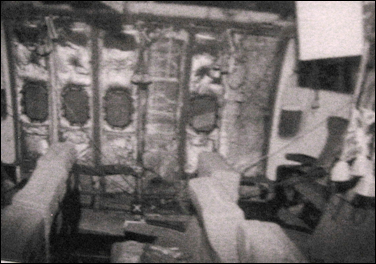
1994 Phillipine Airlines bombing aftermath Terry McDermott wrote in The New Yorker: “The Josefa’s chief recommendation was its location, facing President Quirino Avenue, a main artery connecting the center of Manila with the neighborhood where the Vatican ambassador to the Philippines lived. This provided a strategic advantage for Mohammed and Basit’s latest plan: to assassinate Pope John Paul II. Basit and Mohammed did not appear to have any particular animus toward the Catholic Church; members of Abu Sayyaf suggested the Pope as a target. He had a weeklong visit to Manila scheduled for January, 1995, and would likely travel along President Quirino Avenue several times. [Source: Terry McDermott, The New Yorker, September 13, 2010]
“In late 1994, Shah moved out of the Josefa and Basit moved in. Using various aliases, he collected the materials to make bombs: nitroglycerine, citric and nitric acid, wire, cotton balls, watches. He and Mohammed discussed various ways to kill John Paul, including suicide bombers disguised as priests, remote-control bombs, and an aerial attack. They learned that President Bill Clinton was to visit in the same period, and discussed ways to kill him, too. But Philippine authorities heard rumors of threats against the Pope and added security throughout the capital. Basit and Mohammed, worried that they couldn’t penetrate the heightened defenses, focussed instead on another, more innovative attack.
McDermott wrote in The New Yorker: “Mohammed and Basit were almost indiscriminately ambitious. In addition to blowing up a dozen airliners and killing the Pope and the American President, their plots included assassinations in Pakistan and the Philippines, a bombing in Iran, and attacks on consulates in Pakistan and Thailand, among many others. In one of his Guantánamo statements, Mohammed listed thirty-one terror plots to which he was party. There doesn’t seem to have been much of a plan uniting them. Basit and Mohammed were not criminal masterminds in the conventional sense; they did not sit back and coolly plan attacks. Instead, they reeled from plot to plot as if they were more interested in action — any action — than in its import. They murdered even in the course of practicing for their attacks. When Basit was captured, in February, 1995, he had a bunch of children’s toys stuffed with explosive materials. When Mohammed was arrested in Pakistan, eight years later, he had numerous new plots in various stages of execution, despite having already pulled off the biggest terror attack in history. [Source: Terry McDermott, The New Yorker, September 13, 2010]
Plot to Blow Up a Dozen Airliners Over the Pacific
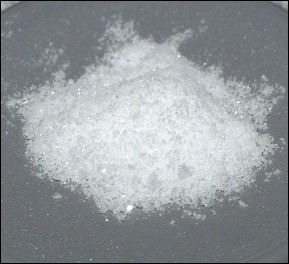
TATP, similar to the
explosive used in the
Philippine Airline attack In the Book: “The Hunt for KSM”, Terry McDermott & Josh Meyer wrote: “The key ingredient in the prospective airplane bomb was nitromethane, which was inexpensive and readily available in the Philippines. Mohammed emptied the contents of fourteen contact lens solution bottles, taking care to not break the plastic seals on the bottles. He then refilled them with the nitro. He carried thirteen of the bottles in his carry-on bag on a flight to Seoul. . . . To test his ability to clear airport security while carrying a metal detonator, Mohammed carried a small metal bolt. He taped the bolt beneath the arch of his foot, then covered his foot with a sock. . . . He set off alarms at the security scanner and was asked to undress. This included his shoes, but not his socks, and he was passed through. He realized later that he had left a detailed plan for the attacks in his carry-on bag; it contained all twelve of the targeted flights as well as the time the bombs were intended to explode. Security officials didn’t notice the plan, but did ask why he was carrying so much contact lens solution. I found a great sale in Manila, he said.”
Raymond Bonner and Benjamin Weiser wrote in the New York Times: “That scheme was developed in Manila by Mohammed as he was starting his climb to become a top lieutenant to Osama bin Laden, and Ramzi Ahmed Yousef, who was a mastermind of the 1993 bombing of the World Trade Center. Philippine investigators came to believe that the Manila operation was financed by Mr. bin Laden... Mohammed code-named the operation Bojinka, which was widely reported to have been adopted from Serbo-Croatian, meaning big bang. But Mr. Mohammed has told his C.I.A. interrogators that it was just a “nonsense word” he adopted after hearing it when he was fighting in Afghanistan during the war against the Soviet Union, according to “The 9/11 Commission Report.” [Source: Raymond Bonner and Benjamin Weiser, New York Times, August 11, 2006]
See Separate Article Plot to Blow Up a Dozen Airliners Over the Pacific factsanddetails.com
KSM Makes Contact with Al-Qaida After the Failed Pacific Jetliner Plot
Terry McDermott wrote in The New Yorker: After Basit’s capture, investigators figured out that Mohammed had been involved in the Manila plot, and that he had helped fund the 1993 bombing of the World Trade Center. (There was a record of a wire transfer, the six hundred and sixty dollars that Mohammed had contributed, into a bank account belonging to one of Basit’s co-conspirators.) He was secretly indicted in New York in early 1996, yet his name never came up in either of Basit’s two lengthy trials. The government, which presumably did not want to warn Mohammed that he was being pursued, did not mention him, and neither did Basit. All the while, Mohammed was living openly in Qatar, occasionally going to work as an engineer in the water department, and travelling around the world. [Source: Terry McDermott, The New Yorker, September 13, 2010]
“Mohammed disappeared from view for at least a year after he fled Qatar, in 1996. He was based in Karachi, but officials in Brazil, Bosnia, the Philippines, and Malaysia say that he travelled to their countries during this time, sometimes more than once. Among the places he visited was Tora Bora, in the mountains of eastern Afghanistan, where he went to meet with bin Laden and seek his sponsorship for a daring new plan. The two knew each other from their days in Peshawar, during the Afghan jihad, but according to Mohammed had not seen each other since 1989.
“Daniel Byman, the former 9/11 Commission staff member, said that Mohammed regarded the encounter as a meeting of equals. He had the cachet of being the uncle of Basit, who was regarded as a hero within radical Islam. Mohammed’s own role in the Manila plot was not widely known, though. Investigators regarded him as subordinate to Basit, his role possibly limited to raising money. This new plan would resolve any doubts about his importance. He didn’t want to join Al Qaeda, he later told his interrogators, but merely sought resources to fund a spectacular attack against the United States. His visit was well timed. Bin Laden had just returned to Afghanistan, having been expelled from Sudan at America’s insistence. In the seven years since Al Qaeda began, in Peshawar, he had greatly expanded the organization’s scope and ambition, and he was now preparing a fatwa to declare war against the United States.
Khalid Sheik Mohammed Hatches the Plan for the September 11th Attack
Khalid said, “I was responsible for the 9/11 operation, from A to Z.” Peter Finn wrote in the Washington Post: “In 1996, when he described his plot for a direct attack on the United States using aircraft as weapons, bin Laden listened but did not immediately commit, according to the 9/11 Commission Report. In late 1998, after al-Qaeda succeeded in bombing the U.S. embassies in Kenya and Tanzania, bin Laden finally approved what the group came to refer to as the "planes operation." Under Mohammed's original plan for Sept. 11, 10 aircraft were to be hijacked. He was to have been aboard the only one not to crash, and after killing the male passengers he was to deliver a speech condemning U.S. support for Israel, as well as the Philippines and governments in the Arab world. The 9/11 Commission Report notes: "This vision gives a better glimpse of his true ambitions. This is theater, a spectacle of destruction with KSM as the self-cast star -- the superterrorist." [Source: Peter Finn, Washington Post, November 14, 2009]
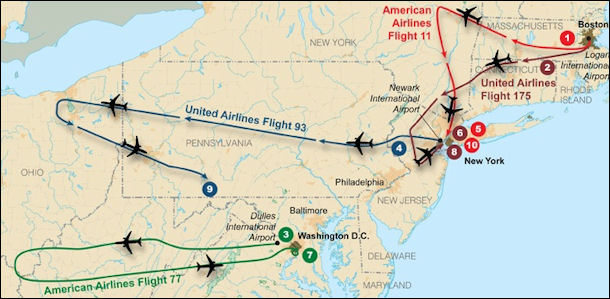
Flight paths of hijacked planes on September 11, 2001
Terry McDermott wrote in The New Yorker: “Mohammed’s initial proposal was to hijack a single airplane and crash it, as Abdul Murad had suggested, into C.I.A. headquarters. Bin Laden dismissed this target as inconsequential. So Mohammed proposed hijacking ten airliners in the United States, some on each coast. The plotters would crash nine of them, and Mohammed would triumphantly land the tenth, disembark, and give a speech explaining what he had done and why. Bin Laden thought that the plan was too complicated. It was not until late 1999 that he approved a somewhat less ambitious proposal: the 9/11 plan. [Source: Terry McDermott, The New Yorker, September 13, 2010]
“The idea was distinguished largely by its simplicity. It required pilots, and teams of men able to overwhelm defenseless air crews. It required money and the ability to move it around the globe. And it required willing suicide bombers — of whom, Mohammed has said, there was a surplus. By far the biggest difficulty was finding volunteers who could legally enter the United States. In two years, Mohammed was able to insert just nineteen men into the plot.
“During the planning of the attacks, Mohammed spent most of his time in Pakistan, and continued to organize plots and local terror cells around the world. He recruited people he had known from the Afghan training camps to form small organizations in their areas. U.S. investigators had no hint of Mohammed’s deepening involvement with Al Qaeda. They wanted him for his association with the Manila plot; that was enough to land him on the F.B.I.”s Most Wanted list, with a two-million-dollar reward. They tracked him, as they tracked bin Laden, but never put the two together.
Khalid Sheik Mohammed Prepares the September 11th Attack
Terry McDermott wrote in The New Yorker: “Mohammed was a hands-off manager; he spent most of his time trying to recruit suitable volunteers and, once he had done so, gave them instructions and expected them to perform. He delegated the details of the plot — which flights, what day, the makeup of the hit teams — to Atta, who communicated his decisions to Mohammed through bin al-Shibh, mainly using coded e-mail exchanges and Internet chat rooms. While the pilots were being trained, Mohammed continued searching for men to join them in the United States. Most of those he found were Saudis who, like the pilots, had gone to Afghanistan to volunteer, and carried passports that allowed them easy access to the U.S. [Source: Terry McDermott, The New Yorker, September 13, 2010]
“Mohammed told investigators that bin Laden urged him several times to hurry up the attacks. He refused, waiting until the summer of 2001, when Atta told him the attack teams were set; in the meantime, he insulated the hijackers from bin Laden’s impatience. He also allowed Atta to overrule bin Laden’s choice of the White House as one of the targets — Atta thought it was too difficult — and substituted the Capitol.”
“Mohammed said that several dozen recruits and associates stayed at his Karachi apartment. One man was there for a two-week training course that ended just before September 11th. Recruits have described the instruction they received as basic — how to use the Yellow Pages, Internet chat rooms, and travel agencies. Mohammed taught them a code to use in their e-mails in which each digit in a telephone number was converted so that the original digit and the coded one added up to ten; for example, Mohammed’s Karachi cell-phone number, 92 300 922 388, became 18 700 188 722. He gave them simple word codes: a “wedding” was an explosion, “market” was Malaysia, “souk” was Singapore, “terminal” stood for Indonesia, and “hotel” for the Philippines. Thus, “planning a wedding at the hotel” would be planting a bomb in Manila. He received notes at various e-mail accounts, including silver_crack@yahoo.com and gold_crack@yahoo.com. (His password was “hotmail.”) Mohammed refused to respond to e-mail that didn’t follow the proper codes.
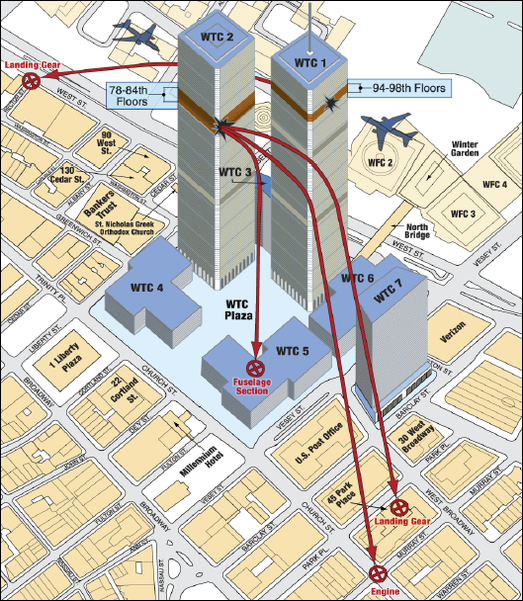
How the planes hit the World Trade Center
“In the summer of 2001, word began to leak out of Afghanistan that Mohammed — or Mukhtar, the “chosen one,” as he was known within Al Qaeda — was planning something big. ...Al Qaeda had called its most important operatives back to Afghanistan, to protect them. In late August, Mohammed travelled to Afghanistan to inform bin Laden personally of the date of the attacks, then returned to Pakistan. ...As the former C.I.A. director George Tenet put it, according to the 9/11 Commission Report, “The system was blinking red.” But, up until the moment of the hijackings, nothing illegal had occurred. That morning, nineteen young Arab men boarded four commercial airliners in much the same way tens of thousands of other men, women, and children did.
Khalid Sheik Mohammed’s Reaction to the September 11th Attack
Terry McDermott wrote in the The New Yorker: “According to a memoir by the former Pakistani President Pervez Musharraf, Mohammed watched news reports of the attacks at an Internet café in Karachi. When the first plane hit the first target, the World Trade Center, a celebration commenced. Bin al-Shibh, who, according to Musharraf, was with Mohammed, told Yosri Fouda that men in their company shouted “God is great!” and wept with joy. [Source: Terry McDermott, The New Yorker, September 13, 2010]
Peter Finn wrote in the Washington Post: “When two planes struck the twin towers of the World Trade Center in Manhattan on Sept. 11, 2001, Khalid Sheik Mohammed was sitting in an Internet cafe in Karachi, Pakistan, monitoring the attacks. At first, Mohammed later told CIA interrogators, he was disappointed. He said that he expected the towers to crumble immediately and that he feared they might not fall at all. [Source: Peter Finn, Washington Post, November 14, 2009]
“After the towers came down, Mohammed returned to a hideaway flat in the city. There, according to newly disclosed details from U.S. officials, he and a number of associates, including Ramzi Binalshibh, al-Qaeda's liaison with the Sept. 11 hijackers, gathered to watch coverage on international news channels. Through the night in Pakistan, the men embraced repeatedly in celebration, marveling at their spectacular success and the humbling of the American giant.”
Image Sources: Wikimedia Commons
Text Sources: New York Times, Washington Post, Los Angeles Times, Times of London, The Guardian, National Geographic, The New Yorker, Time, Newsweek, Reuters, AP, AFP, Wall Street Journal, The Atlantic Monthly, The Economist, Global Viewpoint (Christian Science Monitor), Foreign Policy, Wikipedia, BBC, CNN, NBC News, Fox News and various books and other publications.
Last updated March 2022
